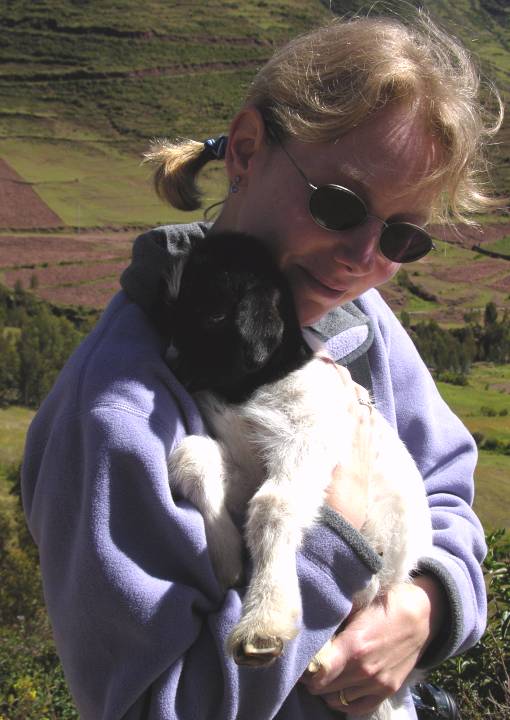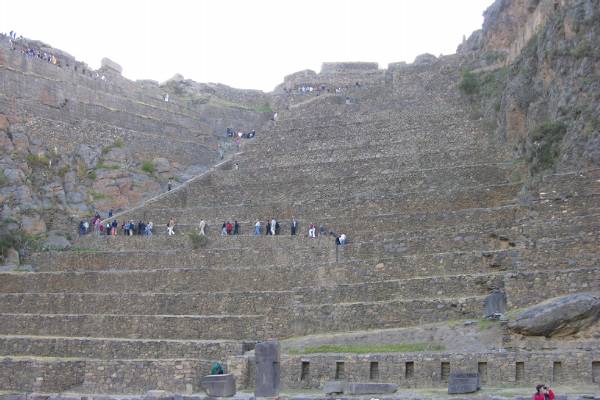< Previous | Next >
We had booked a tour of the Sacred Valley, which is the area around the Urubamba river, but we weren't really sure if we would be picked up or not. We had breakfast in the hotel and when 8.30 came and went we stood outside on the pavement, hoping that someone would come to find us. Much to our surprise they did, and we were led to a coach. It was full of other tourists, many of which were the obligatory loud northerners, and Americans who insisted on moving people out of their seats because they wanted the best views, so we stayed mostly quiet! On every tour there is someone you take an instant dislike to, and in this case it was the pushy American woman who was 20 minutes late, demanded to sit in the front seat and needed a loo stop every half an hour.
It was a beautiful, sunny morning and our guide was excellent. He was Quechua and knew just about everything about everything. He stopped the coach a lot so that we could get out and take pictures, and at the first stop, a beautiful view of the river and the cornfields surrounding it, we met a bunch of Quechua women in traditioal dress wanting us to take photos for a small tip. I was more interested in their llamas..

The scenery was spectacular. It's the end of the wet season now, which means the cold, dry season is starting soon. I guess that equates to autumn, although they only have the two times of year. All the corn and maize was ripe and everywhere people were harvesting their crops with sythes and women were lugging huge sacks of stuff around. The Peruvians have more than 500 varieties of potato and 700 types of maize, and they make almost every meal from one or the other.
We made a slight detour into a mud-brick town that was just starting to be reinhabited after the terrorists had been cleared out. Pigs and dogs and chickens were everywhere, the houses and streets were all made of mud and there was no real drainage at all. Then onto Pisaq, a Quechua town that the Spanish took over. It was really just one big market with people selling rugs and pan pipes and alpaca jumpers, and we were advised not to pay the full price of everything but to haggle, which made me want to wear a fake beard and buy a gourd, but I didn't. The church was closed, which was a shame, and because the market was sprawling so much we didn't get a proper view of the town at all - it looked nicer from the hills above.
A lunch stop at a painfully touristy restaurant followed, but they had llamas and alpacas in the garden and the Titanic song played on pan pipes, so it was all very funny. We drank copious amounts of coca tea, which didn't dull the pan pipes at all, and then we went back to the bus for a trip to Ollantytambo, an ancient Quechua site built on a hill.
As with all the sites built by the Inca, there was a ceremonial fountain, a shrine, and a cleverly-positioned astronomical site through which, on various days of the year, the sun shone in a particular way. Puma Sonel, our guide, still practised the Quechua religion, and made sure that we approached the site in the right way, and explained in detail the work that went into building it. Although it's not apparent from this picture, the shrine was built in the shape of a llama, an important symbol for Quechua, as it represented the present world (the condor symbolised the next world, and the snake the underworld).

The final stop was in a small town called Chinchero which was the place one of the Inca kings built for himself, which was surrounded by meadows and grasslands and was beautiful. Very little of most Inca sites remain because the Spanish took the stones for their own buildings and sent the gold home, and they built a small, very pretty, church on the site of the temple here. Lots of the original foundation blocks were still visible in the church. The other interesting thing about Chinchero was the terraces built into the mountainside, which were for agricultural experiments - different crops grew best in certain conditions and soils, and the Quechua had worked out which altitudes worked best for which plants.
Back to Cuzco by about 6pm, and after a quick walk through town it was back to the hotel. It was cold and we put the heater on. The bed had about eight alpaca blankets which were incredibly heavy, but very warm.
< Previous | Next >
